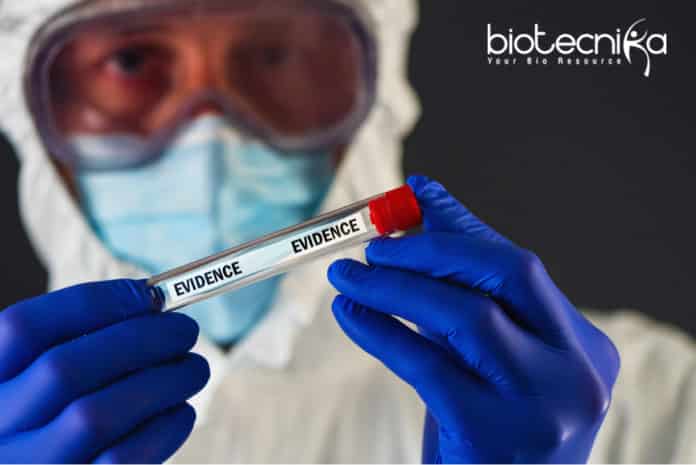Forensic Proteomics, a Novel Tool for Crime Labs and Anthropology
DNA evidence has revolutionized the field of forensic science in the past few years, cracking open cold cases and also by bringing both convictions and exonerations. The same techniques used in this field help archaeologists and anthropologists studying remains from ancient peoples or human ancestors.
But DNA is a relatively fragile molecule which breaks down easily. That is where proteomics, i.e, the new science of analyzing proteins, comes into the picture. By reading the sequences of amino acids from fragments of proteins, researchers can work backward to infer the sequences of DNA that produced the protein.
Glendon Parker who is an adjunct associate professor in the Department of Environmental Toxicology and graduate group in Forensic Sciences at the University of California, Davis, said that this tool helps in reading DNA when you do not have any DNA to read. Protein is much more stable than DNA molecule, and protein detection technology is much better now, Parker added.
Parker’s laboratory at University of California, Davis, with his colleagues including Jelmer Eerkens who is a professor of anthropology, Robert Rice who is also a professor of environmental toxicology and Brett Phinney who
is a manager of the Proteomics Core Facility at the University of California Genome Center, is working now to establish proteomics as a novel tool in forensics and anthropology fields.The proteomics technology could be used where samples are old or degraded, and to back up results from DNA analysis, Parker said. Like genomics which is the study of entire genomes and large amounts of DNA, it is a new field enabled by rapid advances in the protein sequencing technology and also computing.
The proteins are made up of chains of units called amino acids. There are about twenty naturally occurring amino acids that are encoded by DNA. A 3 letter sequence of DNA corresponds to a specific amino acid, so reading the sequences of DNA can give you the amino acid sequences of the corresponding proteins. The DNA sequences can also be deduced by reading the amino acid sequences and comparing them against the databases of known proteins and genes.
The instruments like those at the University of California, Davis, Proteomics Core Facility can work with vanishingly small amounts of protein i.e, as little as about 50 nanograms. An inch of human hair contains about 100 micrograms of protein.
Hair is one of the evidence often found at crime scenes and it has very little DNA but contains more than enough protein (mostly keratin) for analysis. Just by looking at variant amino acids in keratin, scientists can identify single-nucleotide polymorphisms, or SNPs, in the underlying DNA. This information can be used for both personal identifications and also to get information on their ancestry.
Hairs vary depending on where on the body they come from. But a recent research study led by graduate student Zachary Goecker from Parker’s team showed that the differences between hairs from scalp, beard, armpit, and pubic hair are not great enough to affect identification. Some changes such as graying, dyeing and peroxide treatments had no effect on the identifying information from peptides, Parker added. The research study was published in March 2019 in Forensic Science International: Genetics.
For anthropologists, both bones and teeth are a window to people of the past, but DNA in these samples may be in a very poor state. When working with Eerkens, Julia Yip, a graduate student in Parker’s laboratory, developed a novel method to determine an individual’s biological sex based on a single tooth.
That is possible because teeth contain a protein called amelogenin. This happens to be located on the X and Y chromosomes that determine the biological sex of an individual. If a tooth has amelogenin-Y, then the tooth must have come from an individual with XY chromosomes. Therefore the individual most likely to be a biological male.
In the other side-by-side tests, the tooth protein analysis was more sensitive and also reliable for sex determination than either DNA or looking at the anatomy of the skeletons. This research work was published in 2018 in the Journal of Archaeological Science. This study is being followed up by postdoctoral researcher Tammy Buonasera.
In a research paper published in May 2019 in Forensic Science International: Genetics, the research team has also shown that it is possible to get enough proteins for personal identification from a fingermark. The issue here is in finding and collecting the samples rather than the sensitivity of the machine, Parker added.
Parker hopes that the new tool- forensic proteomics, a novel tool-can move out of the laboratories and into some real-world cases. The technique of Forensic proteomics needs to be thoroughly validated before going into wide use, Parker added. But he expects all those “boxes to be checked” within about a year. One of the possible starting points would be working on “cold cases” sexual assault kits that are also being tested for DNA and other evidence.
Parker said that they are trying to get the interest of the forensics community in getting us involved in some of these cases.
Parts of the laboratory’s work of Forensic Proteomics have been supported by grants from the National Institute of Justice, the National Science Foundation, and the National Institutes of Health.






























